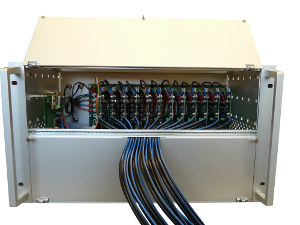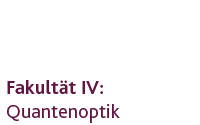Multi-channel Arbitrary Waveform Generator (M-AWG)
Providing versatile trapping potentials to micro-structured ion-traps

Some key features:
- Waveforms: 16 independent arbitrary waveforms per output channel
(up to 8k samples each, up to 128k samples for single waveform) - Output channels: 24
- Output update rate: up to 25 MHz
- Output voltage range: -8V to +8V
- Modes of operation: continued-clock, stopped-clock
- Reference clock: internal, external (up to 25MHz)
- USB 2.0 computer interface, LabVIEW, C (APIs available)
- Digital outputs: 1 (TTL-compatible)
- All I/Os are galvanically isolated
- German Patent [11]
- Published in Review of Scientific Instruments [12]
Ion trap based quantum computing has proven its prominent position in the field of quantum information processing and quantum simulation. Paul traps use RF potentials to trap the ions in 2D, while confinement in 3D requires additional DC potentials. Micro-structured segmented linear Paul traps (in the following termed as micro-traps) have a large number of DC electrodes (e.g. [1, 2, 3, 4, 5, 6]) which are very useful to shuttle [7, 8, 9], to separate and to merge trapped ions as well as for controlling the range and magnitude of the spin-spin coupling between the ions [10].
We have developed a precise Multi-channel Arbitrary Waveform Generator (M-AWG) [11] which has the ability to create versatile trapping potentials. The M-AWG consists of 12 daughter cards mounted on a motherboard (see picture above). Each of the daughter cards has two potential generating channels with a common CPLD (complex programmable logic device) and Dual-Port SRAM. Each of the channels consists of a 16-bit DAC followed by a DC-offset voltage adder and an amplifier. All outputs of the M-AWG are fed to a router which connects any particular output to any single electrode (or multiple electrodes) of the microtrap simultaneously. The memory on the daughter card is uploaded from a control computer via a USB 2.0 interface under control of an FPGA. The device can be operated at an update rate of up to 25 MHz with a power consumption of less than 35W. The device is easily scalable to any desired number of channels and is suitable for applications with fast update rates which allows to implement fast ion shuttling in segmented traps as well as the creation of multiple trapping zones, for example, to generate cluster states which are interesting for measurement based quantum computing.
References:
- [1] Hensinger et. al., Appl. Phys. Lett. 88(3), 034101 (2006)
- [2] Schulz et. al., New J. Phys. 10(4), 045007 (2008)
- [3] Brown et. al., Nature 471, 196-199 (2011)
- [4] Harlander et. al., Nature 471, 200-203 (2011)
- [5] [QIS32] Kaufmann et. al., Appl. Phys B: Lasers and Optics 107, 935-943 (2012)
- [6] Wilpers et. al., Nature Nanotechnology 7, 572-576 (2012)
- [7] Schulz et. al., Fortschritte der Physik 54 (8-10), 648-665 (2006)
- [8] Bowler et. al., Phys. Rev. Lett. 109, 080502 (2012)
- [9] Walther et. al., Phys. Rev. Lett. 109, 080501 (2012)
- [10] [QIS24] Wunderlich et. al., Physical Review A 79, 052324 (2009)
- [11] Baig et. al., German Patent: DE 10 2011 001 399 A1 2012.09.20
- [12] [QIS37] Baig et. al., Rev. Sci. Instrum. 84, 124701 (2013)
